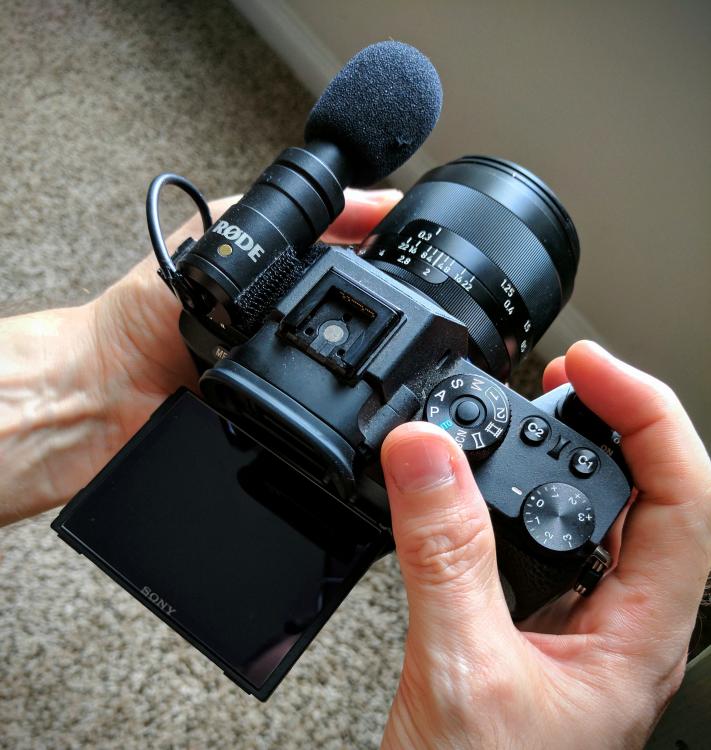-
Posts
1,600 -
Joined
-
Last visited
Content Type
Profiles
Forums
Articles
Everything posted by Don Kotlos
-
I ma not that convinced by the footage yet. Here is a small review that shows quite a bit of vibrations:
-

Sony A7 III first impressions - what is going on with metering in video?
Don Kotlos replied to Andrew Reid's topic in Cameras
Nice pictures & colors! I haven't seen any differences in the metering between video/stills. I use the manual mode and the exposure is consistent between the two. I use the multi metering with face priority. Maybe it is just a setting in that humongous menu. The custom modes on mode dial can be used to switch between the two, but I find the manual mode faster and seem-less. -
Yeah I like the S&Q mode as well. It is very easy to create a nice output, slomo or timelapses. Just keep in mind that if you need the highest quality then the normal 120/1080p uses ~100mbps whereas the S&Q mode uses ~60mbps.
-
I have mentioned that before, but I will do again here: When playing with picture profile settings it is important to change the exposure from -3 to +3 stops in order to observe any potential color shits. Some combinations produce more color shifts than others, so adjusting the exposure for skin is a good tactic in general.
-
My guess is that because the gimbal was unbalanced, it had some residual vibrating motion with a pivot point in front of the camera. That would cause the camera to move in both X & Y and change the YAW/PITCH. You can imaging it as the movement space belonging on the surface of a small sphere. The IBIS of the camera would compensate for the X,Y shifts, but the uncorrected yaw/pitch could bring out this warping. It might be that the rolling shutter & lens distortions exaggerate this effect. While it is very hard for this movement (surface of the sphere) to occur in any natural circumstances, the combination of IBIS with an unbalanced gimbal could do this.
-
No, the only issue with correcting yaw/pitch movement with x/y shifts is that for wide angle lenses the focus plane changes and thus you get corners that are out of focus. With Sony there is no digital stabilization, and with the E-M1II there is an optional extra digital stabilization which can be turned off.
-
While implied, they never showed the sensor tilting. Their claim is that it can correct for yaw/pitch which it can but not very well. Here is a small discussion: https://diglloyd.com/blog/2015/20150823_0800-SonyA7R_II-IBIS.html But you can do the experiment yourself as well. Take the lens off and observe the light reflections off the sensor while you tilt the camera when it is on or off. If it was actually changing the yaw/pitch of the sensor you wouldn't notice the light reflections changing since the angle should remain the same (stabilized). What you will see is that the reflections change the same way when the camera is off or on. You can even do another test to see how with longer focal lengths, tilts of the camera affect the x/y shift more (since their trying to compensate for yaw/pitch).
-
I know it is not a solution for everyone, but I use Lightroom to copy all my footage (stills/clips) and with the "rename during import" function you can adjust the naming as you wish. I use the date + sequential numbering.
-
No I did not. While IBIS can compensate to some degree for yaw/pitch, it cannot change the yaw/pitch of the sensor. The yaw and pitch corrections are really only X/Y IBIS movements. E-M1ii has also digital stabilization thats how you get these artifacts.
-
There is no way for IBIS to create that artifact since it cannot adjust the YAW/PITCH of the sensor. IBIS can only compensate for YAW/PITCH movements by X/Y shifts because with medium to long lenses a YAW/PITCH movement can be approximated as an X/Y shift. That type of transformation that can be seen in that video posted from scotchtape can only arise from an imbalanced/faulty gimbal or digital stabilization.
-
Nobody has really measured it. My guess is that A7III should be better, but once you adjust the exposure for the same DoF the differences should be minimal. For example with FF 50mm at f/1.4 is too shallow for most of shots, but for m4/3 a 25mm at f/1.4 gives you a f/2.8 equivalent FF DoF. When I compare sensor sizes I try to adjust for the differences in DoF, so I would compare the 1600 ISO with m4/3 to the 6400 ISO of A7III. Here is a comparison that Philip Bloom made between GH5s and A7sII/A7rIII (which should be close to A7III?)
-
Panasonic just released the Lumix TS7: https://***URL removed***/news/0758644839/panasonic-lumix-ts7-ft7-is-first-rugged-compact-camera-to-have-built-in-evf Again tiny sensor. Wish that we start seeing at least 1" sensor models soon. The RX0 could have been it. It is not the price or lack of internal 4K that bothers me, but the bad quality of 1080p that it offers. They could have downsampled the 4K image to 1080 which would greatly help with the noise and the aliasing. I have tried the Olympus TG-5, but the video is really disappointing. I have been using the GoPro HERO6 and the quality is alright. In good light at least you can get decent results.
-

Guerrilla shooters? (this thread is not about hunting..)
Don Kotlos replied to kye's topic in Cameras
Yeah I wanted to shrink it as much as I could. I used velcro to mount it on the camera, which also removes some of the vibration transfer from the body. Of course not as good as the native mount. I also modified a cable to reduce the profile of the 3.5" head, but you can find short cables from ebay. -

Guerrilla shooters? (this thread is not about hunting..)
Don Kotlos replied to kye's topic in Cameras
-
Allow. More than any other consumer camera. But I still wish everyone implemented baking in 3DLUTs as the new pocket.
-
The color science has improved on the latest gen Sony cameras (A7III/A7rIII/A9). But if you stick to the same gamma and color gamut they should be fairly close and easily matched in post. Playing with the color depth can help with getting them as close as possible in camera. What I have noticed is that the colors of A7RIII compared to A7rII are generally less greenish, more warm with a more saturated red channel. You can use any of the Cine gammas or the Slog2. The color gammuts that I use most often are Pro/Cinema/sgamut3.cine. If you intend to grade a lot in post then I would use the Slog2/sgamut3.cine on both cameras with a slight increase in saturation (~10). If you want something looking good straight out of the camera, then Cine gammas with Pro/Cinema color or a more saturation with sgamut3.cine work well. Avoid Slog3 and sgamut/3. Since Sony picture profiles allow for extensive manipulation of the image, it is important to get them close to what you like. So spend the time optimizing the settings in-camera, and record test footage before you shoot the main gig!
-
In the US you don't have a problem of getting a citation. Its more likely you will get shot
-
That is the recorder from Saramonic, and the guy even said the sound was ok. He had problems with the menus and handling. On the other hand the Samramonic preamp is just a preamp with a battery. When I was testing that, I found it was comparable to the rm222 juicedlink when used with a Rode NT1-A. It is worth every penny of the $23! There is a dual XLR channel version as well. But I agree with you on the H6, there are better audio recorders for the size/price.
-
I have really enjoyed work from Hiro Murai.
-
The DR100mkiii is bigger than the H5 but if size is a concern then the solution that @Richard Bugg suggested would a great alternative. I have tested the Saramonic coupled to the H1 and it produced excellent results.
-

Does HLG Increase DR When Rendered as Rec 709???
Don Kotlos replied to Mark Romero 2's topic in Cameras
Yes that is correct. But again, rec2020 should be the preferred colorspace in most cases with HDR. -
Yes, zoom H5 works without the modules. But when I was researching for a recorder I found it too noisy. The Tascam DR-100MKIII offers much better quality.
-

Does HLG Increase DR When Rendered as Rec 709???
Don Kotlos replied to Mark Romero 2's topic in Cameras
rec709/rec2020 are colorspaces so the dynamic range wouldn't change. Even though you can record in rec709 in the camera, I am not sure how wide the support for HLG with rec709 is. The standard is rec2020 so probably stick with that one. The benefit of HLG over SLOG for HDR delivery is that you don't have to spend time grading it. You can uploaded from your SD card and it should work. For non HDR delivery I haven't seen any real advantage of HLG with Sony cameras. if anything having to use rec2020 makes color harder to work with. So in the latter case I would stick with Cine/slog gammas with non-rec2020 color spaces. Youtube has support for it so you could potentially just upload your videos with minimal to no grading, but if you really need it then you should definitely find a monitor to see how your footage actually looks . That will give you the ability to do more extensive color grading as well. -
Yeah I would also just just go for 1080p but only if it is artifact free. Thats why for me the best feature of the new pocket is that it can downsample the 4K in camera to 1080p. Hopefully the rolling shutter is similar to the original pocket (maybe @John Brawley can verify that?) and that makes it an amazing 1080p camera.





